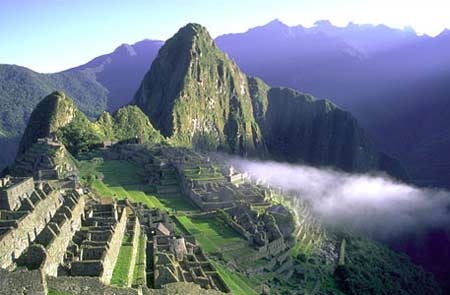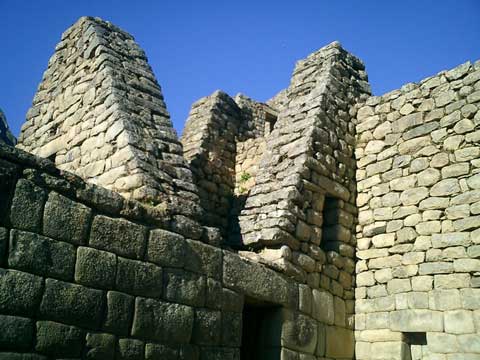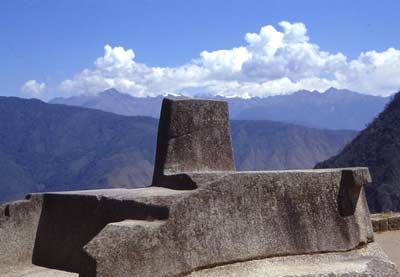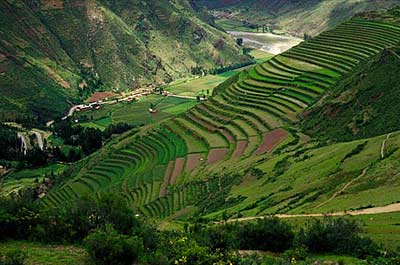In June 1011, an expedition team from Jeru University, led by American explorer Halmebinquy, set out from Cusco to search for a secret stronghold that the remaining faction of the Inca Empire still held after the Spanish conquest of Milu. The result was that the stronghold was not found, but unexpectedly, they discovered an “Incan City in the Sky” that had been abandoned.

Machu Picchu – Peru is shrouded in mist year-round (Photo: karlgrobl)
The area surrounding the “Incan City in the Sky” is approximately 1,400m2, situated at an altitude of 2,300m above sea level, and is covered by mist year-round. The environment surrounding this city is very high and treacherous. The fierce Urumbamba River cuts through Cusco, flowing northward and merging into the Amazon River system. The force of the water has formed dangerous vertical cliffs rising 700m. The Sa ReBan mountain, towering at 6,264m above sea level, is covered with a thick layer of snow extending down to the valleys. The granite rock platform above the dangerous area is the ancient city of Machu Picchu – this city is built against the mountain, with three sides bordered by rivers, appearing to have no way up. The rooms are constructed among the mountains, featuring hundreds of perfect natural stone columns, facilitating repairs and providing comfort for the inhabitants. The city boasts various architectural styles such as: the Sun Temple, altars, royal palaces, noble residences, commoners’ or slaves’ quarters, workshops, and markets. Some rooms intersect like a maze, easy to enter but difficult to exit.

Most of the architecture in the city is built from stone without mortar
(Photo: platinumandblack)
Most of the architecture in the city is constructed from stones without the use of mortar. The stones are interconnected very securely, to the point where not even a blade can fit between them. The stone walls built in public areas weigh tons. The footings are carved directly into the rock floor. The stone quarry site spans 30,000m2. Outside, it can be demonstrated that many stone materials were transported from elsewhere, dragged up the mountain by human strength and sturdy levers. If slaves could not bring stones up, they would be punished. If the thatched roofs of the houses here still existed, Machu Picchu would undoubtedly be deemed the most beautiful city in the world.
To meet the needs of self-sufficiency, the Incas cultivated hundreds of terraced fields on the slopes of the mountains to grow food crops. Each terrace is about 3m high, extending hundreds of meters up to the mountain’s peak, with each layer equipped with channels for irrigation.
On a small mound within the ancient site, there lies a large rectangular stone that is unparalleled. The surface of this stone is polished smooth, with sharp edges, oriented towards the East, and on the stone, a rope as thick as a bowl is tied. Through archaeological verification, this is the famous “Sun Binding Stone”, symbolizing the Incan desire to prevent the Sun from falling, to eternally illuminate the simple emotions on Earth. Additionally, the “Sun Binding Stone” serves as a distinctive solar calendar astronomical device. The Incas of that time knew how to determine seasons through the change of shadows, creating a solar calendar and relying on it for agriculture.

“Sun Binding Stone” (Photo: econ.surrey)
So, when was this citadel built, and under what circumstances was it abandoned? Since the discovery of the “Incan City in the Sky”, there have been numerous scientific hypotheses regarding its existence and disappearance.
BinQuy – the first discoverer, stated: The temples of the ancient city are equipped with three ventilation openings, unlike other Inca sites. Therefore, this could be the birthplace of the creator of the Inca Empire – the first monarch, Mankekapark.
Some scholars believe that Machu Picchu is the “City of the Sun Goddess”. Thus, the male-to-female ratio of the inhabitants in the city is 1:2. Beautiful women chosen to be the Sun Goddess from all over the country were brought here to live a secluded life. Due to the need for secrecy, the subjects were unaware of the existence of this citadel.
To explain the disappearance of this city, archaeologists have pointed to the ancient Inca’s backward technology. They argue that supplying clothing and food for tens of thousands of people is no easy task; encountering natural disasters would leave the ancient Incas unable to sustain their lives, leading to dispersal.
Machu Picchu, while not suffering from natural devastation, faced brutal attacks from tribes in the jungle or at times, devastating civil wars among the rulers, and uprisings by enslaved people. Consequently, most residents perished or fled, leaving this city in the sky abandoned.

Terraced fields behind the mountain (Photo: inkas)


















































